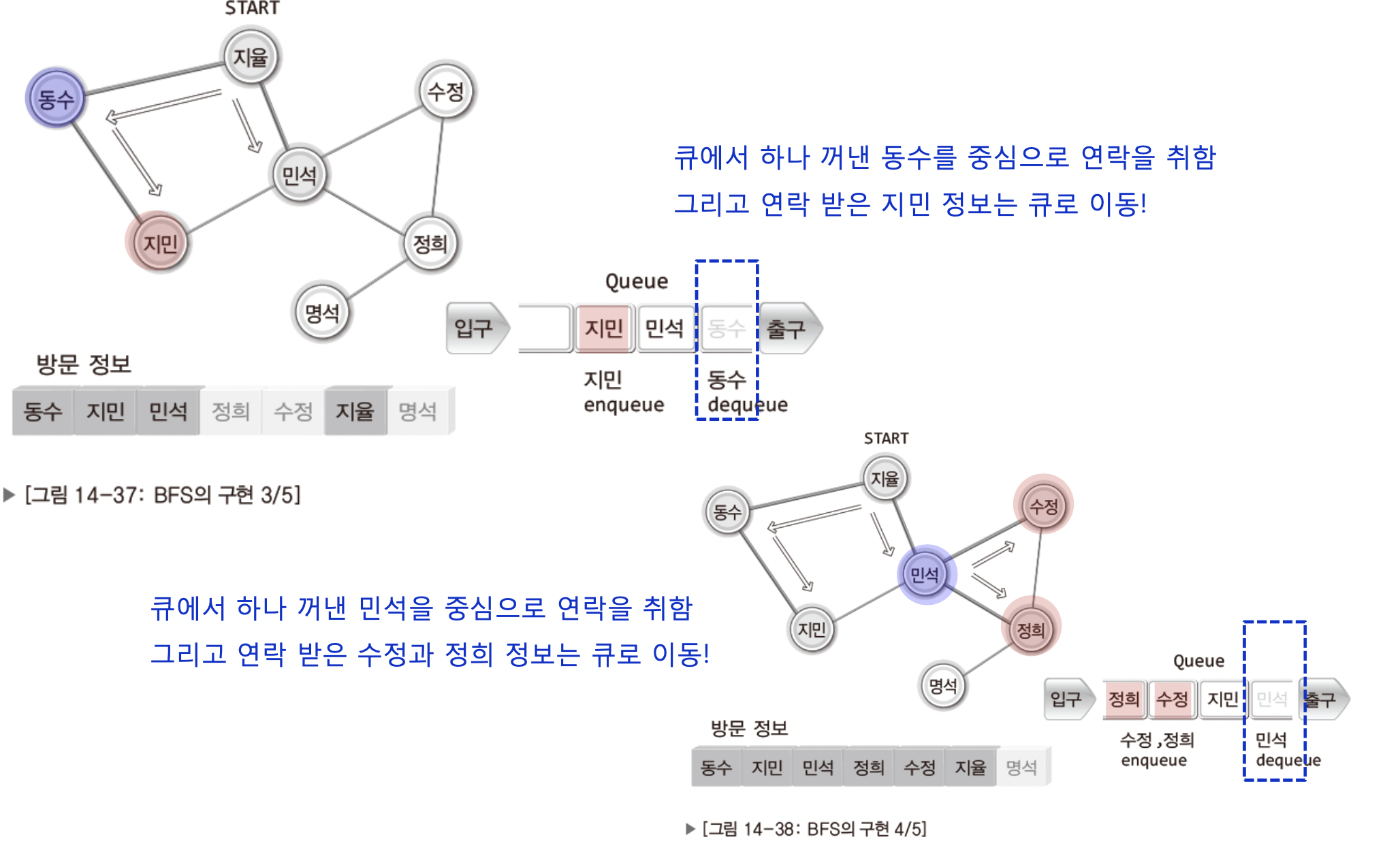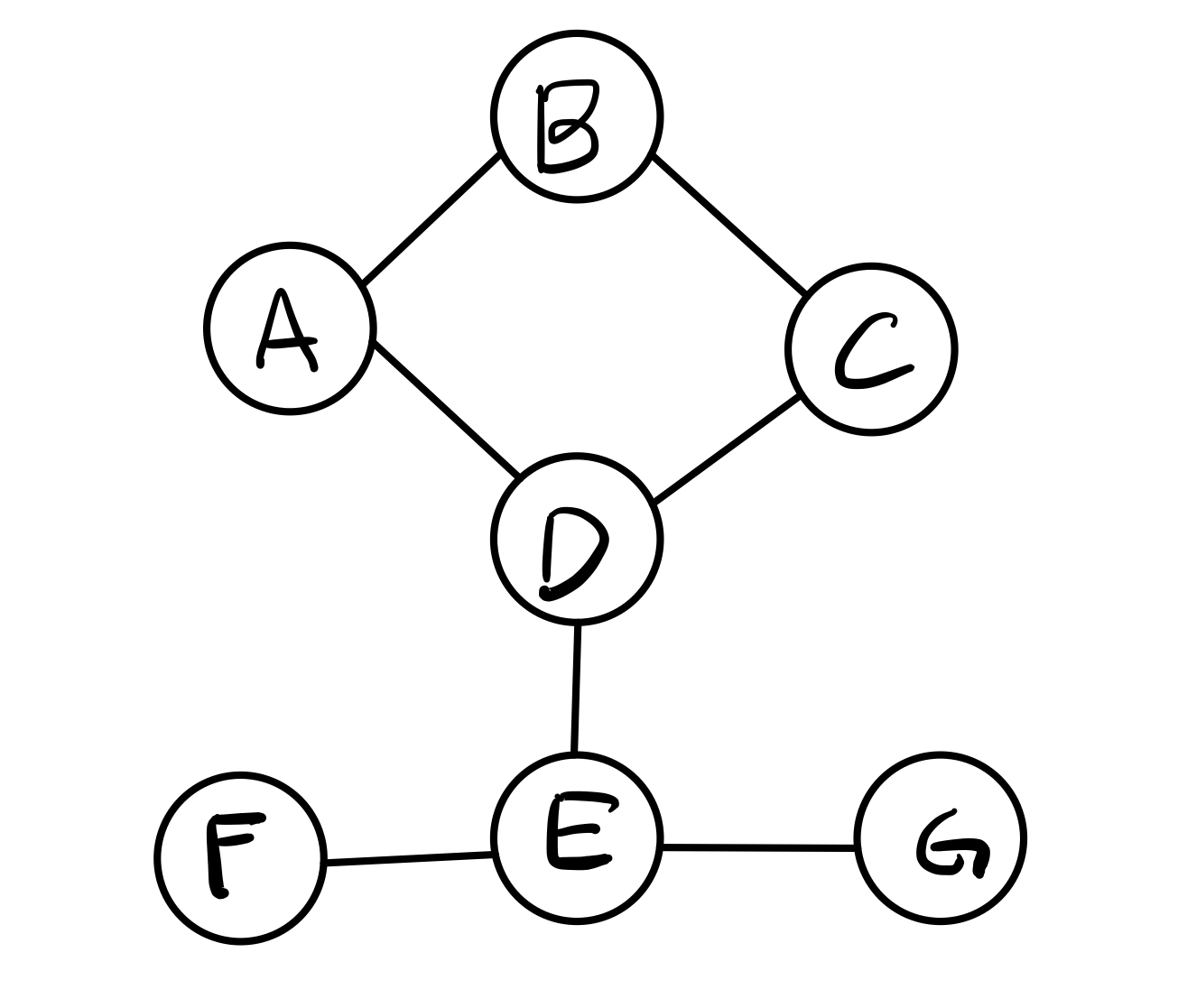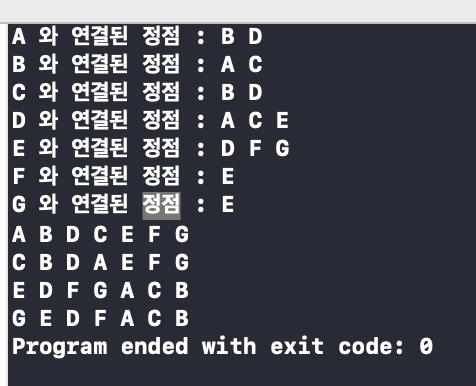BFS는 DFS와 다르게 스택이 아닌 큐를 활용한다.
그러므로
- 큐 : 방문 차례의 기록을 목적
- 배열 : 방문 정보의 기록 목적
이 두개가 필요하다.
우선 그림으로 이해 해보자

이렇게 지율이 부터 시작한다면
지율이는 동수와 민석이에게 연락을 취할것이다.
그럼 이 연락을 받은 동수와 민석을 큐에 넣어주자.

이제 큐를 활용하는것이다!!
큐에서 먼저들어온 동수를 꺼내서 동수를 중심으로 연락을 취하고 그 연락받은 지민은 큐에 들어오게 되는것이다.
그 이후 민석이 연락을 취해서 수정,정희가 들어오고
이후는 정희 말고는 명석에게 전달할 사람이 없으니 전부 빠이루~ 해주는것이다.

그렇게 빠이루 하고나서 정희의 큐가 나오고나면 끝!!!
이 아니다!
명석까지 큐에 들어갔다 나오는 순간
탐색을 종료하게된다.
자 바로 구현해보자!
너비 우선 탐색의 실제 구현
BFS 의 구현은 DFS 에서 showGraphVertex가 BFS 기반으로 한다는 점에서만 다르지만 파일을 새로 만들어주자.
필요한 파일은 다음과 같다.
- ALGraphBFS.c,h : 그래프 관련
- CircularQueue.c,h : 큐 관련
- DLinkedList.c,h : 연결 리스트 관련
- BFSMain.c : main 함수 관련
ALGraph.h
//
// ALGraphBFS.h
// ALGraphBFS
//
// Created by 서희찬 on 2021/04/24.
//
#ifndef ALGraphBFS_h
#define ALGraphBFS_h
#include "DLinkedList.h"
enum {A,B,C,D,E,F,G,H,I,J};
typedef struct _ual{
int numV;
int numE;
List * adjList;
int * visitInfo;
}ALGraph;
//그래프의 초기화
void GraphInit(ALGraph * pg , int nv);
//그래프의 리소스 해제
void GraphDestroy(ALGraph * pg);
//간선의 추가
void AddEdge(ALGraph * pg, int fromV, int toV);
// 간선의 정보 출력
void ShowGraphEdgeInfo(ALGraph * pg);
// 정점의 정보 출력 : DFS 기반
void BFShowGraphVertex(ALGraph * pg, int startV);
#endif /* ALGraphBFS_h */ALGraph.c
//
// ALGraphBFS.c
// ALGraphBFS
//
// Created by 서희찬 on 2021/04/24.
//
#include <stdio.h>
#include <stdlib.h>
#include <string.h>
#include "DLinkedList.h"
#include "ALGraphBFS.h"
#include "CircularQueue.h"
int WhoIsPrecede(int data1,int data2);
void GraphInit(ALGraph * pg, int nv) // 그래프의 초기화
{
int i;
// 정점의 수에 해당하는 길이의 리스트 배열을 생성하낟.
pg->adjList = (List*)malloc(sizeof(List)*nv); // 간선정보를 저장할 리스트 생성
pg->visitInfo = (int*)malloc(sizeof(int)*pg->numV); // 정점의 수를 길이로 하여 배열을 할당
pg->numV = nv; // 정점의 수는 nv에 저장된 값으로 결정
pg->numE=0;// 초기의 간선수는 0개
memset(pg->visitInfo,0,sizeof(int)*pg->numV);
// 정점의 수만큼 생성된 리스트들을 초기화한다.
for(i=0;i<nv;i++)
{
ListInit(&(pg->adjList[i]));
SetSortRule(&(pg->adjList[i]), WhoIsPrecede); //정렬기준유도
}
}
void GraphDestroy(ALGraph * pg)
{
if(pg->adjList != NULL)
free(pg->adjList); // 동적으로 할당된 연결 리스트의 소멸
if(pg->visitInfo != NULL)
free(pg->visitInfo);
}
void AddEdge(ALGraph * pg, int fromV, int toV )
{
// 정점 form V의 연결 리스트에 정점 toV 의 정보 추가
LInsert(&(pg->adjList[fromV]), toV);
// 정점 toV의 연결 리스트에 정점 fromV의 정보 추가
LInsert(&(pg->adjList[toV]), fromV);
pg->numE+=1;
}
void ShowGraphEdgeInfo(ALGraph * pg)
{
int i;
int vx;
for (i=0; i<pg->numV; i++) { // for 문을 돌면서 리스트의 모든 키에 접근한다.
printf("%c 와 연결된 정점 : ",i + 65); // 아스키코드로 !
if(LFirst(&(pg->adjList[i]), &vx)) //vx에 저장된다.
{
printf("%c ",vx+65);
while(LNext(&(pg->adjList[i]), &vx)) // 연결된 노드가 있다면 출력
printf("%c ",vx+65);
}
printf("\n");
}
}
int WhoIsPrecede(int data1, int data2)
{
if(data1<data2)
return 0;
else
return 1;
}
int VisitVertex(ALGraph * pg, int visitV)
{
if(pg->visitInfo[visitV]==0) // visitV에 처음 방문일 때 '참' 인 이프문
{
pg->visitInfo[visitV] = 1; // 방문한것으로 기록
printf("%c ", visitV+65); //방문 정점 이름 출력
return TRUE; // 방문 성공
}
return FALSE; // 방문 실패
}
// DFS -> 정점의 정보 출력
void BFShowGraphVertex(ALGraph * pg, int startV)
{
Queue queue;
int visitV = startV;
int nextV;
QueueInit(&queue);
VisitVertex(pg, visitV);
while(LFirst(&(pg->adjList[visitV]), &nextV)==TRUE)
{
if(VisitVertex(pg, nextV)==TRUE)
Enqueue(&queue, nextV);
while (LNext(&(pg->adjList[visitV]), &nextV)==TRUE)
{
if(VisitVertex(pg, nextV)==TRUE)
Enqueue(&queue, nextV);
}
if(QIsEmpty(&queue) == TRUE)
break;
else
visitV = Dequeue(&queue);
}
memset(pg->visitInfo, 0, sizeof(int)*pg->numV);
}달라진것은 BFShowGraphVertex 함수뿐이다.
주석으로 설명하고 그래프의 탐색에 대해 마무리하겠다.
void BFShowGraphVertex(ALGraph * pg, int startV)
{
Queue queue;
int visitV = startV;
int nextV;
QueueInit(&queue);
VisitVertex(pg, visitV); // 시작 정점을 탐색한다.
// 아래의 반복문에서는 visitV와 연결된 모든 정점에 방문한다.
while(LFirst(&(pg->adjList[visitV]), &nextV)==TRUE)
{
if(VisitVertex(pg, nextV)==TRUE)
Enqueue(&queue, nextV); // nextV에 방문했으니 큐에 저장
while (LNext(&(pg->adjList[visitV]), &nextV)==TRUE)
{
if(VisitVertex(pg, nextV)==TRUE)
Enqueue(&queue, nextV); // nextV에 방문했으니 큐에 저장
}
if(QIsEmpty(&queue) == TRUE) // 큐가 비었다~ 종료 !
break;
else
visitV = Dequeue(&queue); // 큐에서 하나 꺼내서 다시 반복문 시작!~
}
memset(pg->visitInfo, 0, sizeof(int)*pg->numV); // 탐색 정보 초기화
}
자 메인 함수를 보자 !
//
// main.c
// ALGraphBFS
//
// Created by 서희찬 on 2021/04/24.
//
#include <stdio.h>
#include "ALGraphBFS.h"
int main(void)
{
ALGraph graph;
GraphInit(&graph, 7);
AddEdge(&graph, A, B);
AddEdge(&graph, A, D);
AddEdge(&graph, B, C);
AddEdge(&graph, D, C);
AddEdge(&graph, D, E);
AddEdge(&graph, E, F);
AddEdge(&graph, E, G);
ShowGraphEdgeInfo(&graph);
BFShowGraphVertex(&graph, A); printf("\n");
BFShowGraphVertex(&graph, C); printf("\n");
BFShowGraphVertex(&graph, E); printf("\n");
BFShowGraphVertex(&graph, G); printf("\n");
GraphDestroy(&graph);
return 0;
}
이도

이와 같은 형태이다!
이를 실행시키면

이와 같이 나온다.
